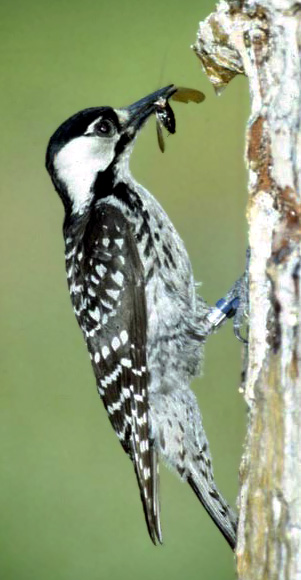- Red-cockaded Woodpecker
Taxobox
name = Red-cockaded Woodpecker
status = VU | status_system = IUCN3.1
trend = down

image_width = 200px
image_caption = Female Red-cockaded Woodpecker
regnum =Animal ia
phylum = Chordata
classis = Aves
ordo =Piciformes
familia = Picidae
genus = "Picoides "
species = "P. borealis"
binomial = "Picoides borealis"
binomial_authority = Vieillot, 1809About the size of the
Northern Cardinal , the Red-cockaded Woodpecker ("Picoides borealis") is approximately 8.5 in. (20-23 cm) long, with awingspan of about 14 in. (36 cm.) and a weight of about 1.5ounce s. Its back is barred with black and white horizontal stripes..Reproduction and development
Red-cockaded Woodpeckers are a territorial, nonmigratory,
cooperative breeding species, frequently having the same mate for several years.The nesting season lasts from April to June. The breeding female lays three to four eggs in the breeding male's roost cavity. Group members incubate the small white eggs for 10-12 days. Once hatched, the nestlings remain in the nest cavity for about 26 days. Upon fledging, the young often remain with the parents, forming groups of up to nine or more members, but more typically three to four members. There is only one pair of breeding birds within each group, and they normally only raise a single brood each year. The other group members, called helpers, usually males from the previous breeding season, help incubate the eggs and raise the young. Juvenile females generally leave the group before the next breeding season, in search of solitary male groups.Range and population level
Historically, this woodpecker's range extended in the southeastern
United States fromFlorida toNew Jersey andMaryland , as far west as easternTexas andOklahoma , and inland toMissouri ,Kentucky , andTennessee . Today it is estimated that there are about 5,000 groups of red-cockaded woodpeckers, or 12,500 birds, from Florida toVirginia and west to southeast Oklahoma and eastern Texas, representing about 1% of the woodpecker's original population. They have become extinct-(extirpated), in New Jersey, Maryland, and Missouri.A map of sightings of the red-cockaded woodpecker in the U.S.A. is in the external links below.Sighting maps of individual states, counties etc. can also be generated at this site. In Texas, red-cockaded woodpeckers can be seen at W.G. Jones State Forest and Sam Houston National Forest. (see external link below)
Habitat
The Red-cockaded Woodpecker makes its home in mature
pine forest s.Longleaf Pine s ("Pinus palustris") are most commonly preferred, but other species of southern pine are also acceptable. While other woodpeckers bore out cavities in dead trees where the wood is rotten and soft, the Red-cockaded Woodpecker is the only one which excavates cavities exclusively in living pine trees. The older pines favored by the Red-cockaded Woodpecker often suffer from afungus calledred heart rot which attacks the center of the trunk, causing the inner wood, the heartwood, to become soft. Cavities generally take from 1 to 3 years to excavate.The aggregate of cavity trees is called a cluster and may include 1 to 20 or more cavity trees on 3 to 60
acre s (12,000 to 240,000 m²). The average cluster is about 10 acres (40,000 m²). Cavity trees that are being actively used have numerous, smallresin wells which exudesap . The birds keep the sap flowing apparently as a cavity defense mechanism againstrat snake s and possibly other predators. The typical territory for a group ranges from about 125 to 200 acres (500,000 to 800,000 m²), but observers have reported territories running from a low of around 60 acres (240,000 m²), to an upper extreme of more than 600 acres (2.40 km²). The size of a particular territory is related to both habitat suitability and population density.The Red-cockaded Woodpecker plays a vital role in the intricate web of life of the southern pine forests. A number of other birds and small
mammal s use the cavities excavated by Red-cockaded Woodpeckers, such aschickadee s,bluebird s,titmice , and several other woodpecker species, including the Downy, Hairy, andRed-bellied Woodpecker s. Larger woodpeckers may take over a Red-cockaded Woodpecker cavity, sometimes enlarging the hole enough to allowEastern Screech Owl s,Wood Duck s, and evenRaccoon s to move in later.Flying Squirrel s, several species ofreptile s andamphibia ns, andinsect s, primarilybee s andwasp s, also will use Red-cockaded Woodpecker cavities.In an effort to increase the Red-cockaded Woodpecker population, states such as Texas, Louisiana, and Georgia's wildlife management is creating artificial cavities in Longleaf Pine trees. There are two methods in which wildlife management officers use to insert cavities in long leaf pines. The most respected and latest approach is to carve out a nesting cavity in the tree and insert a man-made nest. The older and less used approach is to drill a cavity into the tree in hopes that the birds will settle there and nest. [cite web| url=http://www.gpb.org/media/pdf/RedHillsofGa1506.pdf| title=The Red Hills of Georgia (transcript, p. 6)| author=Georgia Public Broadcasting: "Georgia Outdoors"| accessdate = 2007-05-14| ]
References
* Database entry includes a range map and justification for why this species is vulnerable
* [http://rcwrecovery.fws.gov/rcw.htm US Fish and Wildlife Service, Red-cockaded woodpecker]
* [http://www.ebird.org/goTX/GuideMe?source=changeLocation&speciesCodes=recwoo&reportType=species&bMonth=01&bYear=2002&eMonth=12&eYear=2006&parentState=US-TX&getLocations=northAmerica&states=US-TX&countyState=US-TX&hotspotState=US-TX&bcrState=US-TX&continue.x=31&continue.y=11 Ebird Red-cockaded Woodpecker US Distribution]
* [http://tfsweb.tamu.edu/newsroom/fullstory.aspx?id=1092 W.G.Jones State Forest, Conroe,TX]External links
* [http://www.birdlife.org/datazone/species/index.html?action=SpcHTMDetails.asp&sid=653&m=0 BirdLife Species Factsheet.]
* [http://www.nature.org/animals/birds/animals/redcockaded.html The Nature Conservancy's Species page: Red Cockaded Woodpecker]
* [http://www.iucnredlist.org/search/rangemap.php?species=17258 RangeMap] IUCN
* [http://vireo.acnatsci.org/search.html?Form=Search&SEARCHBY=Common&KEYWORDS=red-cockaded+woodpecker&showwhat=images&AGE=All&SEX=All&ACT=All&Search=Search&VIEW=All&ORIENTATION=All&RESULTS=24 Red-cockaded Woodpecker photo gallery] VIREO
* [http://ibc.hbw.com/ibc/phtml/especie.phtml?idEspecie=3880 Red-cockaded Woodpecker videos] on the Internet Bird Collection
* [http://www.visitcitrus.com/protected-birds.asp A little bit more about the Red-cockaded Woodpecker and a few other endangered birds]
Wikimedia Foundation. 2010.
